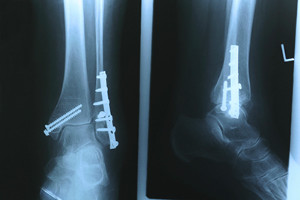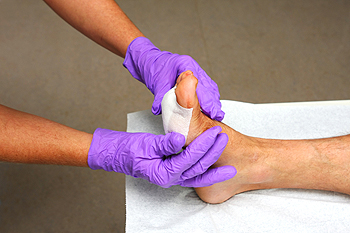Items filtered by date: October 2023
Causes and Symptoms of Diabetic Neuropathy

Diabetic neuropathy most often affects the peripheral regions or extremities, including the feet, which tend to bear the greatest brunt of diabetic nerve damage. Prolonged periods of uncontrolled high blood sugar can trigger a number of problematic conditions that can afflict your feet, collectively termed the diabetic foot. This encompasses a range of issues, ranging from neuropathy related numbness and tingling to more severe complications such as ulcers and infections. Proper diabetes management, a healthy lifestyle, and regular check ups with a podiatrist are essential for preventing or managing this condition, particularly when it affects the feet and lower limbs. Early intervention and a proactive approach to diabetic neuropathy can make a significant difference in preserving your overall well being. If you develop a cut or sore on your foot that does not show signs of healing over time or becomes infected, it is essential to consult a podiatrist as soon as possible. Burning sensations, tingling, weakness, or pain in your feet are often early signs of neuropathy, and should be addressed promptly. For help with this condition, it is suggested that you make an appointment with a podiatrist, who is medically trained to treat diabetic neuropathy.
Diabetic foot care is important in preventing foot ailments such as ulcers. If you are suffering from diabetes or have any other concerns about your feet, contact one of our podiatrists from Montgomery Foot Care Specialists. our doctors can provide the care you need to keep you pain-free and on your feet.
Diabetic Foot Care
Diabetes affects millions of people every year. The condition can damage blood vessels in many parts of the body, especially the feet. Because of this, taking care of your feet is essential if you have diabetes, and having a podiatrist help monitor your foot health is highly recommended.
The Importance of Caring for Your Feet
- Routinely inspect your feet for bruises or sores.
- Wear socks that fit your feet comfortably.
- Wear comfortable shoes that provide adequate support.
Patients with diabetes should have their doctor monitor their blood levels, as blood sugar levels play such a huge role in diabetic care. Monitoring these levels on a regular basis is highly advised.
It is always best to inform your healthcare professional of any concerns you may have regarding your feet, especially for diabetic patients. Early treatment and routine foot examinations are keys to maintaining proper health, especially because severe complications can arise if proper treatment is not applied.
If you have any questions please feel free to contact our office located in Montgomery, AL . We offer the newest diagnostic and treatment technologies for all your foot and ankle needs.
Gout Pain Can Be Managed
Foot and Ankle Stress Fractures

Stress fractures are tiny, gradual bone cracks caused by overuse or repetitive activities, common in athletes. Unlike sudden regular fractures, they develop over time, often affecting the feet and lower limbs. Risk factors include excessive stress, hard surfaces, and rapid changes in exercise intensity. Other causes are weak muscles, joint issues, osteoporosis, medications, poor footwear, and vitamin deficiencies. Symptoms include localized pain, swelling, tenderness, and discomfort during high-impact activities. Diagnosis involves a physical assessment, potentially followed by an X-ray or MRI. Treatment includes rest, compression, training modification, and low-impact activities. Supportive footwear, custom foot orthotics, anti-inflammatories, and exercises can also help. Surgery may be needed in severe cases. Ignoring stress fractures can lead to complete fractures, non-healing, bone necrosis, and surgery. If you are experiencing foot or ankle pain, it is strongly suggested that you make an appointment with a podiatrist who can properly diagnose the issue and provide treatment options.
Activities where too much pressure is put on the feet can cause stress fractures. To learn more, contact one of our podiatrists from Montgomery Foot Care Specialists. our doctors can provide the care you need to keep your pain free and on your feet.
Dealing with Stress Fractures of the Foot and Ankle
Stress fractures occur in the foot and ankle when muscles in these areas weaken from too much or too little use. The feet and ankles then lose support when walking or running from the impact of the ground. Since there is no protection, the bones receive the full impact of each step. Stress on the feet can cause cracks to form in the bones, thus creating stress fractures.
What Are Stress Fractures?
Stress fractures occur frequently in individuals whose daily activities cause great impact on the feet and ankles. Stress factors are most common among:
- Runners
- People affected with Osteoporosis
- Tennis or basketball players
- Gymnasts
- High impact workouts
Symptoms
Pain from the fractures occur in the area of the fractures and can be constant or intermittent. It will often cause sharp or dull pain with swelling and tenderness. Engaging in any kind of activity which involves high impact will aggravate pain.
If you have any questions please feel free to contact our office located in Montgomery, AL . We offer the newest diagnostic and treatment technologies for all your foot and ankle needs.
Non Diabetic Foot Wounds

Foot and ankle infections, while less common in nondiabetic individuals, require prompt recognition and treatment. Patients with these types of infections often experience symptoms such as pain, swelling, reddening, and visible foot wounds. Medical conditions like renal insufficiency or inflammatory diseases can compromise immunity. Persistent reddening of the skin may indicate cellulitis. It is important to inspect the foot for calluses, blisters, and wounds as well as assess the wound size, depth, and any exposed tendons. A joint examination is necessary to evaluate motion and stability. Neuropathy can develop in nondiabetic individuals due to various factors. Imaging, lab tests, and culturing soft tissue or fluid can assist in diagnosis. Nail disorders require specific consideration. Cellulitis responds to antibiotics, while necrotizing fasciitis demands surgical intervention. Timely diagnosis and treatment are important in managing foot and ankle infections in nondiabetic individuals. If you have a foot wound that is not healing, it is strongly suggested that you make an appointment with a podiatrist for evaluation and treatment.
Wound care is an important part in dealing with diabetes. If you have diabetes and a foot wound or would like more information about wound care for diabetics, consult with one of our podiatrists from Montgomery Foot Care Specialists. our doctors will assess your condition and provide you with quality foot and ankle treatment.
What Is Wound Care?
Wound care is the practice of taking proper care of a wound. This can range from the smallest to the largest of wounds. While everyone can benefit from proper wound care, it is much more important for diabetics. Diabetics often suffer from poor blood circulation which causes wounds to heal much slower than they would in a non-diabetic.
What Is the Importance of Wound Care?
While it may not seem apparent with small ulcers on the foot, for diabetics, any size ulcer can become infected. Diabetics often also suffer from neuropathy, or nerve loss. This means they might not even feel when they have an ulcer on their foot. If the wound becomes severely infected, amputation may be necessary. Therefore, it is of the upmost importance to properly care for any and all foot wounds.
How to Care for Wounds
The best way to care for foot wounds is to prevent them. For diabetics, this means daily inspections of the feet for any signs of abnormalities or ulcers. It is also recommended to see a podiatrist several times a year for a foot inspection. If you do have an ulcer, run the wound under water to clear dirt from the wound; then apply antibiotic ointment to the wound and cover with a bandage. Bandages should be changed daily and keeping pressure off the wound is smart. It is advised to see a podiatrist, who can keep an eye on it.
If you have any questions, please feel free to contact our office located in Montgomery, AL . We offer the newest diagnostic and treatment technologies for all your foot care needs.
Facts About Gout

Gout is a painful form of arthritis that can affect anyone, but it is more common in men and those with a family history of the condition. Furthermore, the risk of gout increases with age. Gout typically presents with sudden and severe joint pain, most commonly in the big toe, but it can affect the ankles and other joints. The affected joint becomes red, swollen, and tender to the touch. Gout occurs due to excess uric acid levels in the blood, leading to the formation of sharp urate crystals in the joints. This build-up can be due to genetics, dietary choices, obesity, excessive alcohol consumption, or medical conditions such as kidney disease. Managing gout involves both lifestyle changes and medical intervention. Lifestyle modifications can include adopting a low-purine diet, limiting alcohol intake, and maintaining a healthy weight. Medications, such as nonsteroidal anti-inflammatory drugs, colchicine, and urate-lowering drugs, can help control pain and prevent future flare-ups. If you suspect you have gout in the big toe or ankle, seeking prompt medical attention from a podiatrist is suggested. This type of doctor can effectively manage gout and help you to lead a more pain-free life.
Gout is a foot condition that requires certain treatment and care. If you are seeking treatment, contact one of our podiatrists from Montgomery Foot Care Specialists. our doctors will treat your foot and ankle needs.
What Is Gout?
Gout is a type of arthritis caused by a buildup of uric acid in the bloodstream. It often develops in the foot, especially the big toe area, although it can manifest in other parts of the body as well. Gout can make walking and standing very painful and is especially common in diabetics and the obese.
People typically get gout because of a poor diet. Genetic predisposition is also a factor. The children of parents who have had gout frequently have a chance of developing it themselves.
Gout can easily be identified by redness and inflammation of the big toe and the surrounding areas of the foot. Other symptoms include extreme fatigue, joint pain, and running high fevers. Sometimes corticosteroid drugs can be prescribed to treat gout, but the best way to combat this disease is to get more exercise and eat a better diet.
If you have any questions please feel free to contact our office located in Montgomery, AL . We offer the newest diagnostic and treatment technologies for all your foot and ankle needs.
Effective Foot Exercises for Plantar Fasciitis

Plantar fasciitis can be an agonizing condition, characterized by inflammation of the plantar fascia, a thick band of tissue that runs along the bottom of your foot. While rest, wearing proper footwear, and professional guidance are key to recovery, certain foot exercises may also help provide relief. Toe curls are an effective stretch, and are done while sitting in a chair and placing a towel on the floor. Scrunch the towel toward you using your toes, then release, and repeat several times. Many patients feel the benefits of performing the ankle alphabet. This is accomplished by writing the alphabet in the air with the big toe while seated. Heel raises are done by standing, and raising the heels off the ground, then lowering them slowly. Repeat to strengthen calf muscles. The towel stretch is performed while sitting with your legs extended. Place a towel around your toes and gently pull it toward you to stretch the plantar fascia. These exercises can help to improve flexibility, strength, and blood circulation in the foot, which can aid in plantar fasciitis recovery. If you have plantar fasciitis, it is strongly suggested that you are under the care of a podiatrist who can help you find relief by recommending other specific stretches.
Plantar fasciitis can be very painful and inconvenient. If you are experiencing heel pain or symptoms of plantar fasciitis, contact one of our podiatrists from Montgomery Foot Care Specialists. our doctors can provide the care you need to keep you pain-free and on your feet.
What Is Plantar Fasciitis?
Plantar fasciitis is the inflammation of the thick band of tissue that runs along the bottom of your foot, known as the plantar fascia, and causes mild to severe heel pain.
What Causes Plantar Fasciitis?
- Excessive running
- Non-supportive shoes
- Overpronation
- Repeated stretching and tearing of the plantar fascia
How Can It Be Treated?
- Conservative measures – anti-inflammatories, ice packs, stretching exercises, physical therapy, orthotic devices
- Shockwave therapy – sound waves are sent to the affected area to facilitate healing and are usually used for chronic cases of plantar fasciitis
- Surgery – usually only used as a last resort when all else fails. The plantar fascia can be surgically detached from the heel
While very treatable, plantar fasciitis is definitely not something that should be ignored. Especially in severe cases, speaking to your doctor right away is highly recommended to avoid complications and severe heel pain. Your podiatrist can work with you to provide the appropriate treatment options tailored to your condition.
If you have any questions please feel free to contact our office located in Montgomery, AL . We offer the newest diagnostic and treatment technologies for all your foot and ankle needs.

